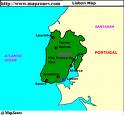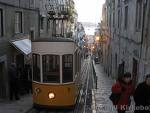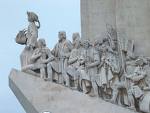TRAVEL REPORT FROM PORTUGAL
We left Seattle on British Air for London on Wednesday at 10:00 pm. A very late hour for someone who is usually in bed by 9:30. It was a full flight. Who said the airlines are hurting because no one is flying? We then had a four plus hour layover before getting our next flight to Lisbon, Portugal at 8:00 pm and arrive at 10:30 pm. Talk about a long travel day! We will be dead for two days after arrival.
 We plan to spend several days in Portugal and fly on to Scotland where we take the Royal Scot train to Edinburgh where we spend some time before going on to London to take in a stage play before heading home.
We plan to spend several days in Portugal and fly on to Scotland where we take the Royal Scot train to Edinburgh where we spend some time before going on to London to take in a stage play before heading home.
While waiting for our next flight in London we talked to the couple next to us who turned out to be from Portugal, but who spend several months a year in Ballard. Luis, the husband has operated a fishing business in Alaska for many years and we had much in common to talk about, especially commercial fishing in the Bering sea where his ships operate.
We left London at 8:00 pm and arrived in Lisbon at 10:30 pm. Immigration was quick and our first three bags came off immediately, but our last one did not. We waited 20 minutes and the belt stopped. We waited another 20 minutes before it started up again with baggage and finally the bag arrived. By the time we drove to the hotel and checked in it was after midnight when we got to bed. Before going to bed we walked out on the balcony. The lights of the town and the lights on a very long suspension bridge crossing the river were beautiful at night and the air was warm.
The next day, Friday was beautiful. The Lapa Palace where we are staying is up on a hill, above Lisbon, in a residential area where various countries embassies are also located. Our room is facing the river harbor high above town with two large balconies giving a 180 degree view. In the morning we had breakfast at the highest balcony area from our room you get to by walking up stairs. Across the river from us is an enormous tower structure with the figure of Jesus with arms outstretched. It is a copy of the same figure in Brazil. Looking through binoculars you can see just how high and huge this structure is.
The prediction is rain on Saturday so we decided to explore by car and driver Friday. Fortunately, almost everyone speaks English as Portuguese is a difficult language for me. That’s because while many of the words are spelled like Spanish they have a very different pronunciation. I am trying to speak it even though they speak English to us.
Lisbon is the capital of Portugal. It is located at the mouth of the Tejo River. This river extends from Spain to the Atlantic ocean. The harbor is huge, an expanse of many miles. Romans and Moors populated Lisbon and in the 15th and 16thcentury. Their influence is in the language and the archaeological designs. Lisbon was a major trading center in those centuries. Vasco de Gama opened new trade routes and it was a prosperous area of great importance. However, the original Lisbon was  destroyed. On the morning of All Saints Day in 1755 there was a large underwater earthquake off the coast of Portugal. Tremors were felt all over Europe. Two thirds of Lisbon was leveled. Fires were started from overturned stoves and candles that burned what had not been destroyed by the quake. A huge tsunami caught the survivors by surprise and many thousands of people lost their lives. We are seeing what was rebuilt from this disaster.
destroyed. On the morning of All Saints Day in 1755 there was a large underwater earthquake off the coast of Portugal. Tremors were felt all over Europe. Two thirds of Lisbon was leveled. Fires were started from overturned stoves and candles that burned what had not been destroyed by the quake. A huge tsunami caught the survivors by surprise and many thousands of people lost their lives. We are seeing what was rebuilt from this disaster.
After breakfast we got a car and driver for a trip to nearby Sintra and then across the mountain, along the coast and back to our hotel. When the hotel said our car was ready I went out and saw a man in a suit I assumed was our driver who was standing by an expensive car which. So I walked up and introduced myself using my Portuguese. He looked a little startled and gave me his name. Of course it turned out he wasn’t our driver. Another man sitting in a van saw this and got out and walked over. I used my Portuguese again and introduced myself. He was a driver alright, but not our driver. By now the man for the hotel began looking for our driver and found him. We left before I got to know any more strangers standing outside our hotel door.
On our drive some things stood out for me. The first was graffiti. Lots of it and everywhere. What a shame to cover so many old buildings, walls and anything available with spray paint. I’ve seen graffiti everywhere we travel, but this was more then I have seen before.
As we drove, I noticed the highway we were on had several lanes but there were no dividing lines painted on the surface. Traffic was light, but, I suspect they don’t have lines because no one would pay any attention in heavy traffic. Driving here, like Italy is an art and pedestrians had better be on alert at all times in cities.
After we left the highway for the rural areas we were on narrower roads. I saw a lot of people on bikes which isn’t a problem in most places we drove. However, as we crossed the mountain for the Atlantic  ocean shore the road became narrow and with many blind curves. Two cars could pass but with little room to spare and a bus would occupy the entire road. Yet we came across a lot of people on bikes on this narrow dangerous road even though cars go fifty miles an hour and honk on blind curves. I wonder how many bikers have been run over by a tourist coming around a curve only to find a bike moving at a slow speed.
ocean shore the road became narrow and with many blind curves. Two cars could pass but with little room to spare and a bus would occupy the entire road. Yet we came across a lot of people on bikes on this narrow dangerous road even though cars go fifty miles an hour and honk on blind curves. I wonder how many bikers have been run over by a tourist coming around a curve only to find a bike moving at a slow speed.
There is tile everywhere as we drove through small villages. Tile decoration on buildings and even sidewalks are often small tile in patterns. Large court yard areas are tile and it is very lovely.
There are forts all along the Atlantic coast from the eighteenth century. Portugal declared itself neutral, as did Spain, in World War II so there are no modern war bunkers as you find in other parts of Europe from the great war.
Our first destination, Sintra, is only 15 miles from Lisbon and is a small town at the foot of hill. Lovely homes and Palaces are located here. There are narrow streets climbing up hill and shops to visit. While we were in Sintra a bus load of German tourists arrived. I was struck by the difference between the sound of German being spoken from Portuguese. To my ear German sounds like someone giving orders and Portuguese like someone singing.
After traversing the mountain and arriving at the coast the coast has large sandy beaches as well as rugged coastline like Newfoundland. I particularly liked the town of Cascais and would like to have spent more time there then we did. This fishing village had a fish market which I visited, but it was too late in the day to see fish being sold. Fishing boats are in the small harbor and lobster pots stacked along the water.
We ate a restaurant along the ocean and had sea bass fixed Portuguese style which was very good. A glass of wine, some ham and bread and we were very happy.
Back in Lisbon we stopped at the famous Monument to the Discoveries. Large figures of famous people involved in exploration are set out in a large stone background on the water’s edge. It is located where many of the explorers sailed from on the way to their explorations. We were back in our room before 5:00 and sat on the balcony in the warm sun. Jet lag is catching us so naps are required.
We ate at the hotel restaurant Friday night. It was over an hour from the time we ordered to the arrival of our salads. The bottle of wine saved us. By the time we got our dinner and finished it was over two hours. Not exactly a fast food place.
Today is Saturday. It rained very hard last night, but today the sun is out and we plan to visit places in Lisbon starting with the flea market where the chief occupation is said to be pickpockets. A report to follow. We leave for Madeira Sunday.
